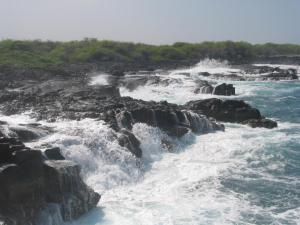Waves a dominant force in Hawaii shoreline habitat creation
University of Hawaiʻi at MānoaPublic Information Officer, Office of the Vice Chancellor for Research
Chris Bird, (361) 825-6024
Assistant Professor, Biology, Texas A&M University - Corpus Christi
It all started with the question, “Why are Hawaiian rocky shores so different than those in California or Maine?” This simple question led to a novel methodology to classify shorelines worldwide, developed by a team of scientists at the University of Hawai‘i at Mānoa and Texas A&M University - Corpus Christi.
For biologists with one toe in the water, the intertidal zone is much more than a gradient from wet to dry. It’s not enough to say that something is located in middle of the shoreline, or high along the shoreline, or even in the "barnacle zone." The mid-shore of Hawai‘i is washed by waves most of the time, while the mid-shore of Maine is alternately under water or in air for six continuous hours. That exposure has a dramatic effect on the types of animals and plants that can be found there.
“It's all about stress,” says lead author Chris Bird, assistant professor of biology at Texas A&M University - Corpus Christi, who was a postdoctoral scholar at the UH Mānoa Hawaiʻi Institute of Marine Biology (HIMB) during the project. “Life is adapted to typical conditions. Rare occurrences are stressful. Common and rare occurrences for shoreline species are substantially affected by whether that shore is either tide- or wave-dominated, and by where on the shore an organism lives.”
Working with co-authors assistant researcher Erik Franklin and researcher Robert Toonen of HIMB and professor Celia Smith in the UH Mānoa Department of Botany, Bird has proposed a new approach to defining the zones that make up intertidal habitat worldwide. Their study was recently published in the scientific journal PeerJ.
Their new wave and tide model of zonation (wave:tide) can be applied to any shoreline worldwide. By examining the relative contribution of waves and tides to shoreline water height, the model predicts three primary categories for intertidal shores: tide-dominated, wave-dominated, and co-dominated (when wave height is equal to tidal range). Within these categories, a tidally influenced differentiation between emergent and submergent zones helps to further refine the description. One of the anonymous PeerJ scientific reviewers commented that the model “…improves upon all the earlier models of Colman, Doty and the Stephensons,” referencing the work of several of the leading 20th century tidal zone biologists.
Worldwide, the majority of offshore oceanic islands are predicted to be wave-dominated and the majority of continental shores are predicted to be tide-dominated on average, according to the new model. Wave-dominated shores are most prevalent in the Southern Ocean where winds blow around the globe with few land barriers. Hawai‘i’s shores are consistently washed with waves regardless of the tide, and are considered to be wave-dominated.
And within each zone there are creatures that have adapted to thrive in the unique combination of sun and air exposure, temperature, water coverage, and other factors that are features of a particular shoreline environment.
To the extent that waves and tides define shoreline habitat, changes in wave heights and tidal patterns such as those that could result from climate change could have major impacts on local biology. “For instance, northern California is co-dominated and could easily be pushed to wave-domination if average wave heights increase,” Bird said. “This would result in ‘new’ habitat and potentially unforeseen changes in shoreline organism community structure and composition.”
The researchers plan to extend their study by continuing to refine the model using wave meter, temperature, and biotic survey data from Hawai‘i. They are also investigating the strange impact the wave zone has had on the evolution of local intertidal species.
“Ha'uke'uke are sea urchins without protective spines,” said Bird. “He'e pali (rock-clinging octopus) don't venture below the water line. And, we've already seen that opihi seem to have speciated in direct response to the shoreline habitats predicted by the wave:tide zonation model.”
Citation: Bird CE, Franklin EC, Smith CM, Toonen RJ. (2013) Between tide and wave marks: a unifying model of physical zonation on littoral shores. PeerJ 1:e154 http://dx.doi.org/10.7717/peerj.154

